Integrations have become a new norm in the tech world, with more than half of all services relying on third-party integrations.
Even the businesses that use internal software prefer using an integrated system that helps them fetch the necessary information, all in one place.
Application integration is at the heart of this data exchange and added services, as it allows a user to be significantly more efficient without having to shuffle through multiple interfaces to complete a process. It’s like bringing different things together to make it work.
So what is Application Integration? What are the types of app integrations? More importantly, why does it matter in a mobile app development process? Well, these are some of the many questions that we are going to answer throughout this guide.
Without further ado, let’s start by understanding the definition of Application Integration.
An Overview of Application Integration
Application integration refers to the process of integrating multiple applications and processes into a single app that can be used by the user to get things done in real time.
It is often kept in line with the data integration process; however, it is more comprehensive and gives more flexibility than simply compiling data for consolidation.
App Integration is like making sure all the interconnected apps can understand each other’s language and work in harmony, just like a team that has a synchronized course of action.
Application integration tends to connect different applications together, allowing them to trigger processes on their own for a larger process to be completed and the objective to be achieved.
The best example of app integration can be a payment application where you have a single interface that not only is connected with the banking app to fetch your personal account information, but it is also connected to a payment gateway that allows the transfer of funds.
However, that is not the only way app integration works. There are several more examples given below to give you a better understanding.
Application Integration Examples
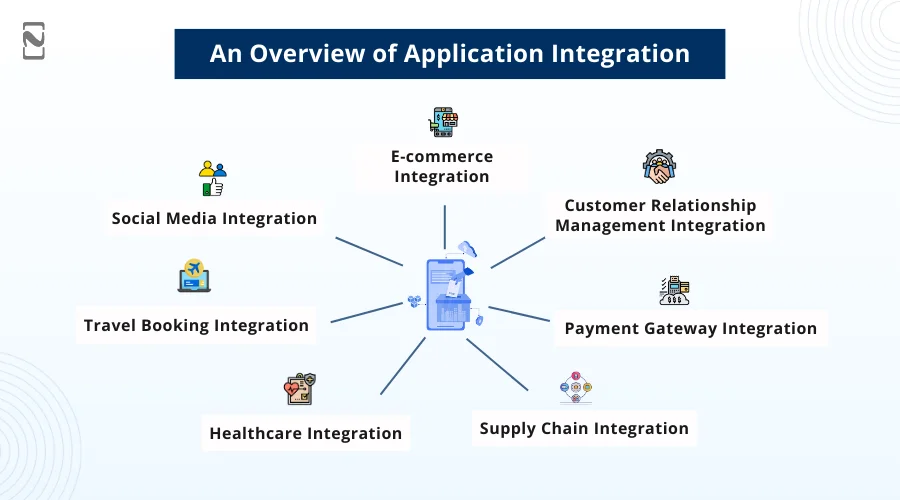
-
E-commerce Integration
Imagine you’re running an online store. By integrating your e-commerce platform with your inventory management system, orders are automatically updated in real time, ensuring accurate product availability information for your customers.
-
Customer Relationship Management (CRM) Integration
Let’s say you’re using a CRM system to manage customer interactions. Integrating it with your email marketing software allows you to create targeted email campaigns based on customer behavior, improving engagement and sales. You can also check your email deliverability with Warmy to ensure your messages consistently reach your audience’s inbox.
-
Payment Gateway Integration
If you have an online payment gateway system, integrating it with your accounting software simplifies the tracking of transactions.
This way, payment information is automatically recorded, reducing manual data entry.
-
Supply Chain Integration
Suppose you’re overseeing a complex supply chain.
Integrating your suppliers’ systems with your inventory and production systems helps you optimize stock levels, reducing overstock or stockout situations.
-
Healthcare Integration
In a healthcare setting, integrating electronic health records (EHR) with laboratory systems means test results are directly recorded in the patient’s file, improving accuracy and saving time for medical staff.
-
Travel Booking Integration
If you’re managing a travel agency, integrating your booking system with airlines and hotels ensures that you receive real-time availability updates.
This leads to more accurate bookings and minimizes booking errors.
-
Social Media Integration
Let’s say you’re handling social media for your business. Integrating social media platforms with a social media management tool allows you to schedule posts across multiple channels and track engagement in one place.
With all these examples, you might have gotten a solid understanding of what is meant by application integration.
These examples also offer a key insight into how crucial it is for modern applications to have app integration.
Other than the sheer fact that it simplifies and optimizes the functionality of an app, the application integration has several benefits.
Check them out in the next section!
Why is Application Integration Important?
Application integration is often misunderstood to be a small part of the process. In reality, it is one of the most important things to take into consideration when building an app.
From fetching commands to completing the process and returning the result to a single interface, the application integrates and adds a lot of convenience to the overall functioning of your app.
There are several reasons why application integration is considered a crucial part of the process. Some of the most crucial ones you must know include seamless information flow between different processes.
Since everything is interconnected in the functioning of the application, the business processes are streamlined to the extent that automation can be achieved for the majority of the involved processes.
Application integration becomes further important for a business as it allows an app to be ready faster.
The time-to-market for your application is significantly reduced when you choose app integration rather than building functionalities manually. It saves time and makes it more efficient to work.
Last but not least, the power of app integration allows you to be more forward with the latest technologies and features.
Since these applications are already available in the market, integrating them can help you leverage the audience that they have gathered without your developers having to struggle with coding and testing the outcome.
Types of Application Integration Used in Development
While it makes a lot of sense to use the app integration, you must understand what type of integration will fulfill your requirements.
You see, the idea of integration simply refers to joining two types of apps or processes together to work in a synchronized manner.
However, when combining two or more applications, you need to understand what kind of arrangement will support the proper exchange of data between the
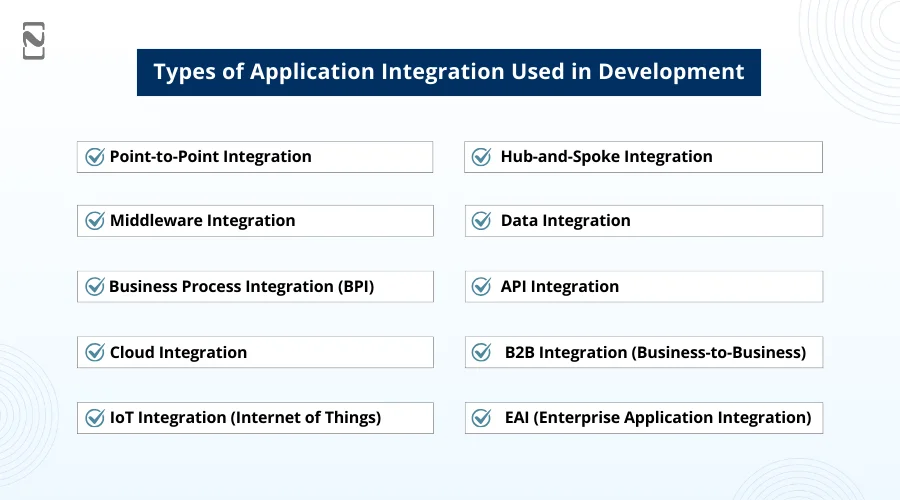
But what are these types? Well, let’s discuss all of that below:
1. Point-to-Point Integration
In this approach, you establish direct connections between specific applications for particular tasks.
Keep in mind that as the number of applications increases, managing these connections can become complex.
2. Hub-and-Spoke Integration
With this method, you use a central hub or intermediary to connect all your applications.
Instead of creating direct links between each application, they connect to a central hub. It then distributes data and services efficiently.
3. Middleware Integration
Middleware serves as an intermediary layer between your applications, aiding communication and data exchange.
It offers services like message queuing, data transformation, and routing. Think of it as a way to simplify interaction.
4. Data Integration
Focus on ensuring that data from various sources is accessible to your applications.
This involves merging, transforming, and cleaning data to offer a unified and consistent view across your systems.
5. Business Process Integration (BPI)
Integrate processes and workflows of your different applications to streamline end-to-end business processes.
It’s about optimizing how your systems work together to improve overall efficiency.
6. API Integration
APIs define how your software components interact. Use these interfaces to connect your applications and exchange data and functionality seamlessly.
7. Cloud Integration
Connect your on-premises systems with cloud-based applications and services. This combination allows you to take advantage of both environments effectively.
8. B2B Integration (Business-to-Business)
Connect with other businesses or organizations to enable smooth data and process exchange. Useful for collaboration in supply chain management and similar scenarios.
9. IoT Integration (Internet of Things)
Link devices, sensors, and data streams to your applications and systems. This real-time connection enables data collection, analysis, and automation in various contexts.
10. EAI (Enterprise Application Integration)
EAI covers a wide range of integration techniques and tools to connect various software applications within your organization seamlessly. It ensures a smooth flow of information and processes.
Remember, the integration approach you choose should align with your organization’s needs and the systems you’re working with.
To achieve the best results and make the most of these types, you need to familiarize yourself with the concepts that are involved in the application integration process.
Check out the next section, where we have curated a list of must-know concepts for successful app integration.
Must-Know Concepts of Application Integration
Now, in an effort to better understand the application integration concept, let’s look at some key aspects of the same.
These are highly crucial for an individual to understand, as they help in the better execution of application integration on any platform.
These concepts are generally mastered by the Application integration experts that you hire; however, you still must have a basic knowledge of the concepts to get the ball rolling
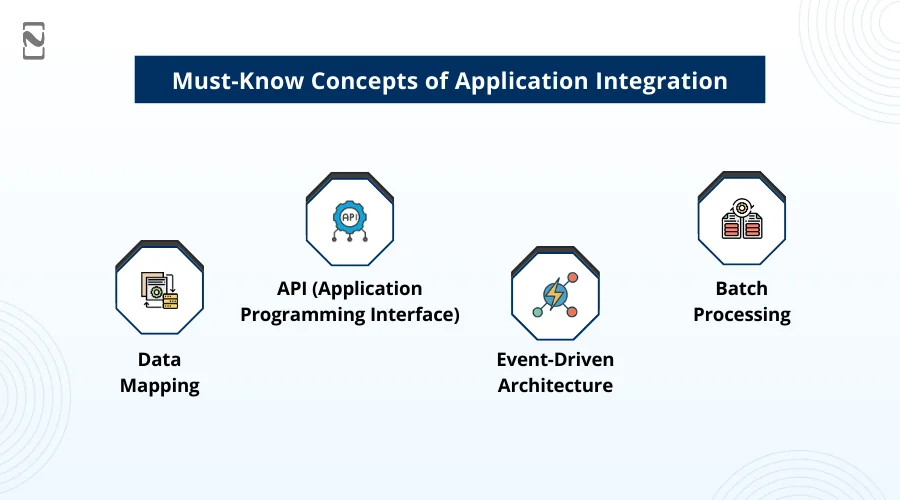
Here are the concepts that we are talking about –
♦ Data Mapping
When you’re integrating applications, data mapping helps you define how data from one system corresponds to data in another.
This mapping allows the data to be more accurately presented as per the requirement, across the application, for a better understanding of the user.
♦ API (Application Programming Interface)
APIs act as bridges between different applications, allowing them to communicate and share data.
It is one of the most commonly used methods to integrate applications and allows the base app to fetch data from different sources in real-time.
♦ Event-Driven Architecture
In an event-driven architecture, actions or events in one application trigger responses in others.
If an application requires automated control, event-driven architecture is the best way to move forward.
♦ Batch Processing
Batch processing involves collecting and processing data in groups or batches rather than in real time.
This approach is useful for scenarios where immediate data exchange isn’t necessary, such as overnight data updates.
With all those concerts, you might have gotten a solid understanding of application integration.
One of the key problems that many individuals face is that they are unable to distinguish between app integration and data integration.
These concepts will help you understand the differences between the two.
If you still have your doubts about the same, here’s a quick comparison between the two that will help you understand the key differences between them.
| Aspect | Application Integration | Data Integration |
| Focus | Aligning processes and workflows across applications. | Consolidating data from multiple sources into one. |
| Interaction | Ensures applications work together seamlessly. | Brings data together for analysis, reporting, etc. |
| Functionalities | Integrates features and functions across applications. | Focuses on unifying data, regardless of function. |
| Complexity Management | Reduces complexity as applications grow. | Manages complexity due to data from multiple sources. |
| Real-Time | Allows real-time collaboration and event-based triggers. | Can be done in batches or real-time, depending on need. |
| Examples | E-commerce platform with an inventory system, CRM with email marketing. | Combining sales data and customer profiles from various sources. |
Advantages And Disadvantages of Application Integration
Application development offers a series of advantages and disadvantages based on how and where it is implemented.
It is only fair that we discuss both aspects in this post, as it will give you better insights into how application integration can be beneficial for you and where exactly your decision of using the integration can go wrong.
Advantages of Application Integration
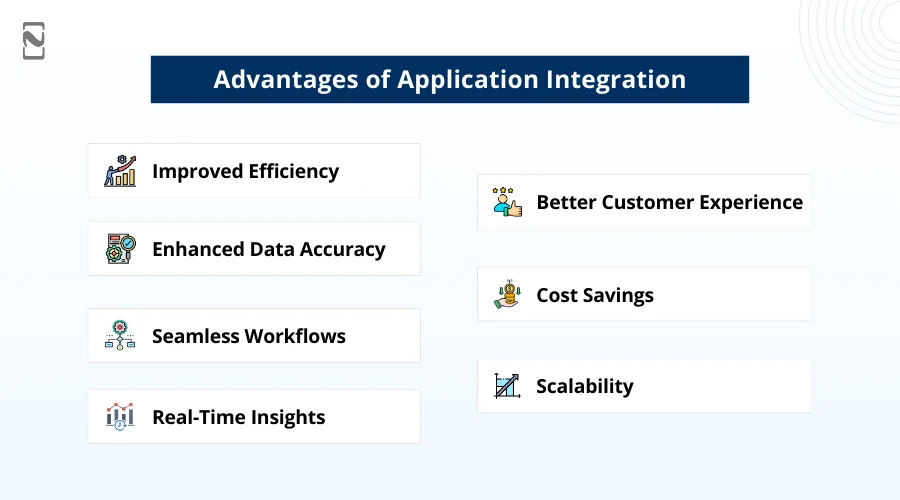
- Improved Efficiency: When you integrate applications, tasks that require manual data entry or switching between systems can be automated. This boosts efficiency by reducing human errors and minimizing repetitive work.
- Enhanced Data Accuracy: Integration ensures that data is consistent and up-to-date across systems. This means you’re working with accurate information, leading to better decision-making and reduced risks.
- Seamless Workflows: With integrated applications, processes flow smoothly across systems. This means fewer delays, less rework, and faster completion of tasks.
- Real-Time Insights: Application integration allows data to be exchanged in real time. This means you can access current information for timely analysis, reporting, and decision-making.
- Better Customer Experience: When different systems communicate seamlessly, customer interactions become more efficient. For instance, integrated customer support systems provide agents with immediate access to relevant customer data.
- Cost Savings: Though integration might require an initial investment, the long-term cost savings are substantial. Automation reduces labor costs, while accurate data helps in avoiding costly errors.
- Scalability: As your organization grows, application integration scales with you. You can add new applications while maintaining a cohesive IT environment.
Disadvantages of Application Integration
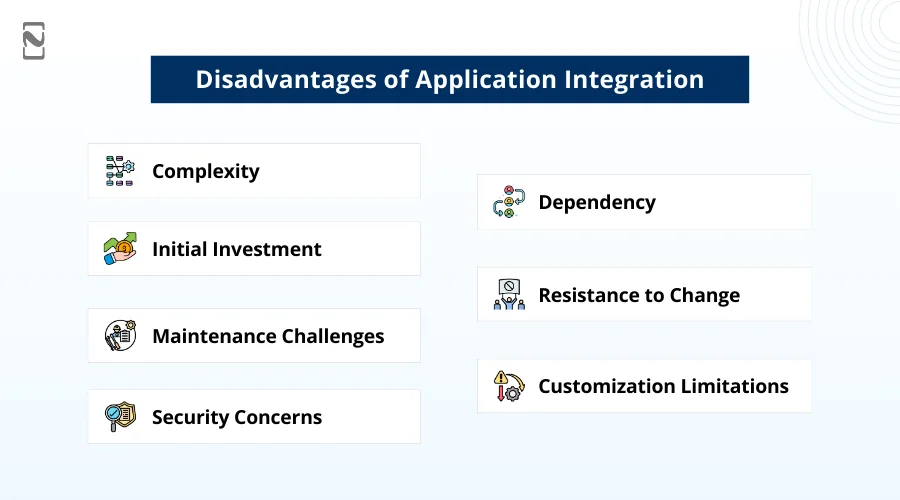
- Complexity: Integration can be complex, especially as the number of applications increases. Choosing the right integration approach and managing interconnected systems can be challenging.
- Initial Investment: Integrating applications might require upfront costs for software, development, and training. It’s important to weigh these costs against the long-term benefits.
- Maintenance Challenges: Over time, integrated systems may require maintenance, updates, and bug fixes. Ensuring continuous compatibility can be demanding.
- Security Concerns: Integrating applications can expose potential security vulnerabilities. Data breaches in one application could potentially affect the connected systems.
- Dependency: When applications are tightly integrated, a failure in one can disrupt the entire chain. A single point of failure can have a cascading impact on multiple processes.
- Resistance to Change: Employees might resist using new integrated systems, especially if they’re accustomed to existing workflows. Proper training and change management are essential.
- Customization Limitations: Some applications might not be easily customizable or compatible with integration methods, limiting your options.
Remember, while application integration offers numerous benefits, it’s important to carefully plan and consider your organization’s specific needs, resources, and potential challenges before embarking on an integration journey.
Best Application Integration Frameworks
To make the most out of the advantages and reduce the impact of disadvantages, you need to use the best application integration practices.
The first step is to choose the right integration framework, which can reduce the headache of enabling integrations and simplify the job with future-proof flexibility.
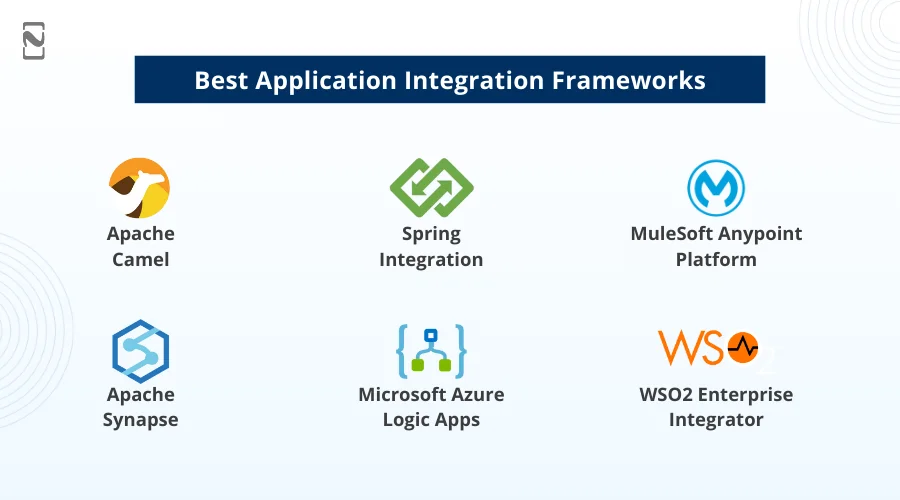
Here are some frameworks that experts use:
1. Apache Camel
If you’re looking for a versatile application integration framework, Apache Camel can be a good option.
Not only does it provide a wide range of connectors, but it also offers components to facilitate seamless communication between various systems and applications.
Some key features include:
- Enterprise Integration Patterns (EIPs): Apache Camel is built on a foundation of EIPs, which are proven design patterns for handling integration challenges.
- Vast Component Library: It offers a rich set of components to connect with various protocols, databases, messaging systems, and APIs.
- Routing and Transformation: Apache Camel enables you to define routing rules and perform data transformation easily, ensuring smooth data flow.
2. Spring Integration
Spring Integration, as the name suggests, allows you to use smooth integration with the Spring ecosystem, making it seamless for you to access different Spring projects.
Here are some notable features that make it a good option:
- Integration with Spring Ecosystem: It seamlessly integrates with other Spring projects like Spring Boot and Spring Cloud, making it an excellent choice for Spring-based applications.
- Message-Driven Architecture: Spring Integration is built around messaging patterns, allowing you to create event-driven, decoupled systems.
- Adapters and Channels: It provides a variety of adapters to connect with different systems, and channels for communication between components.
3. MuleSoft Anypoint Platform
If you’re looking for a comprehensive integration platform, MuleSoft’s Anypoint Platform offers both integration and API development capabilities.
Its features include:
- API-Led Connectivity: MuleSoft follows an API-first approach, making it easy to create, manage, and reuse APIs in your integrations.
- Design Studio: Anypoint Studio offers a graphical interface for designing and testing integration flows.
- Pre-Built Connectors: MuleSoft provides a wide range of connectors to popular systems and applications, reducing development time.
4. Apache Synapse
Apache Synapse is an open-source ESB (Enterprise Service Bus) that provides mediation and message routing capabilities.
Key features of Apache Synapse include:
- Message Mediation: Synapse supports transformation, routing, and protocol conversion of messages.
- Proxy Services: It enables you to create residential proxies that route internet traffic through real residential IP addresses, making it simpler for websites to detect automated activity. They offer enhanced privacy, security, and access to geo-restricted content while mimicking real user behavior.
- Quality of Service (QoS): Synapse supports various QoS features like throttling, security, and reliable messaging.
5. Microsoft Azure Logic App
If you’re in the Microsoft ecosystem, Azure Logic Apps offers a serverless integration platform.
Notable features include:
- Visual Workflow Designer: Logic Apps provides a visual designer for creating workflows that integrate with various services and applications.
- Built-In Connectors: It offers a wide range of connectors for popular services like Office 365, Salesforce, and Azure services.
- Triggers and Actions: Logic Apps allows you to trigger workflows based on events and perform actions in response.
6. WSO2 Enterprise Integrator
For those seeking a comprehensive integration solution, WSO2 Enterprise Integrator provides a range of integration patterns and features.
Key features include:
- Integration Patterns: It supports a wide array of EIPs, making it suitable for complex integration scenarios.
- Microservices Integration: WSO2 EI provides tools and features for integrating microservices and managing their interactions.
- Data Transformation: It supports data transformation using various data formats and protocols.
Keep in mind that the choice of integration framework depends on your specific requirements, existing technology stack, and the complexity of your integration needs.
Evaluate these frameworks based on their features, community support, and how well they align with your organization’s goals.
Conclusion
With all that information explored, you might have a solid understanding of what application integration is, why it is important, what the pros and cons of using it are, and the possible tools required to implement it.
Ideally, you should connect with a mobile app development company to get things done in a swifter way.
Understandably, application integration is the right choice if you plan to build an app that is future-ready and modular for better services.
If you are wondering who can help you or where to find assistance with app integration, then you are at the right place.
Nimble AppGenie is one of the leading names in the app development market and can help you identify the right approach to application integration.
With that said, we have reached the end of this post. Hopefully, the information shared is helpful. In case you have any queries, please feel free to contact us.
Thanks for reading, good luck!
FAQs

Niketan Sharma, CTO, Nimble AppGenie, is a tech enthusiast with more than a decade of experience in delivering high-value solutions that allow a brand to penetrate the market easily. With a strong hold on mobile app development, he is actively working to help businesses identify the potential of digital transformation by sharing insightful statistics, guides & blogs.
Table of Contents




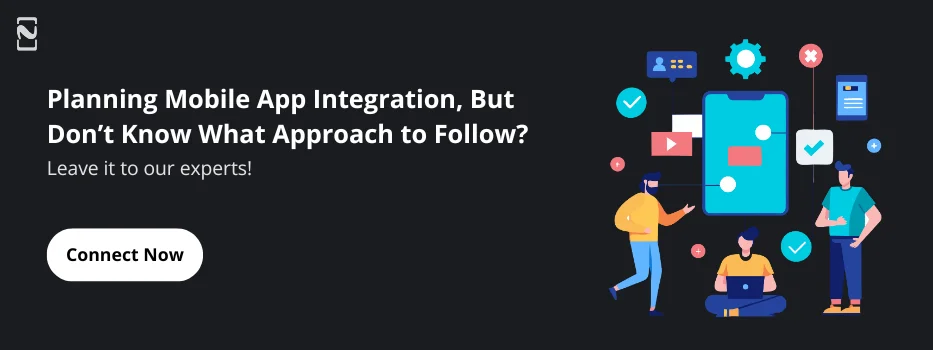
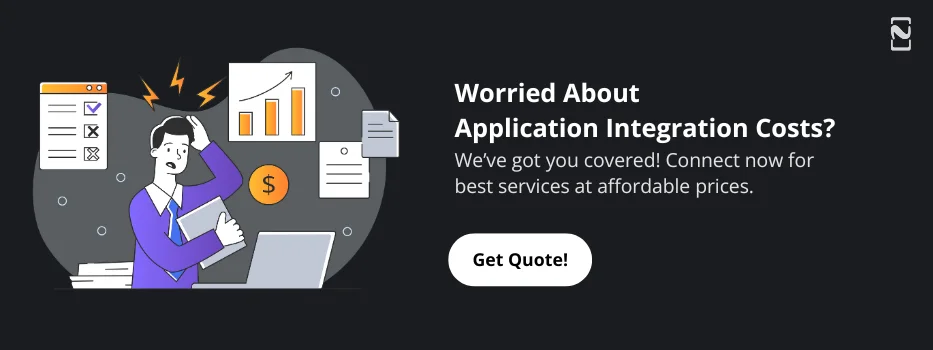
No Comments
Comments are closed.